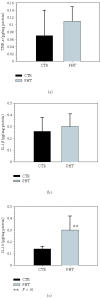Proinflammatory liver and antiinflammatory intestinal mediators involved in portal hypertensive rats
- PMID: 16030393
- PMCID: PMC1533904
- DOI: 10.1155/MI.2005.101
Proinflammatory liver and antiinflammatory intestinal mediators involved in portal hypertensive rats
Abstract
Proinflammatory (TNF-alpha , IL-1beta, and NO) and antiinflammatory (IL-10, CO) levels were assayed in serum, liver, and small bowel in order to verify a hypothetic inflammatory etiopathogeny of portal hypertension that could be the cause of its evolutive heterogeneity. Male Wistar rats were divided into one control group (n=11) and one group with a triple stenosing ligation of the portal vein (n=23) after 28 days of evolution. In one subgroup of portal hypertensive rats, portal pressure, collateral venous circulation, mesenteric vasculopathy, and liver and spleen weights were determined. In the remaining rats with portal hypertension TNF-alpha, IL-1beta, and IL-10 were quantified in liver and ileum by enzyme-linked immunosorbent assay. NO synthase activity was studied in liver and ileum. CO and NO were measured in portal and systemic blood by spectrophotometry and Griess reaction, respectively. Portal hypertensive rats with mayor spleen weight show hepatomegaly and mayor development of collateral circulation. Ileum release of IL-10 (0.30 +/- 0.12 versus 0.14 +/- 0.02 pmol/mg protein; P< .01) is associated with a liver production of both proinflammatory mediators (TNF-alpha: 2 +/- 0.21 versus 1.32 +/- 0.60 pmol/mg protein; P< .05, IL-1beta: 19.17 +/- 2.87 versus 5.96 +/- 1.84 pmol/mg protein; P=.005, and NO: 132.10 +/- 34.72 versus 61.05 +/- 8.30 nmol/mL; P=.005) and an antiinflammatory mediator (CO: 6.49 +/- 2.99 versus 3.03 +/- 1.59 pmol/mL; P=.005). In short-term prehepatic portal hypertension a gut-liver inflammatory loop, which could be fundamental in the regulation both of the portal pressure and of its complications, could be proposed.
Figures





References
-
- Bosch J, Pizcueta P, Feu F, Fernandez M, Garcia-Pagan JC. Pathophysiology of portal hypertension. Gastroenterol Clin North Am. 1992;21(1):1–14. - PubMed
-
- MacMathuna P, Vlavianos P, Westaby D, Williams R. Pathophysiology of portal hypertension. Dig Dis. 1992;10(suppl 1):3–15. - PubMed
-
- Bosch J, Garcia-Pagan JC. Complications of cirrhosis. I. Portal hypertension. J Hepatol. 2000;32(suppl 1):141–156. - PubMed
-
- Garcia-Tsao G. Portal hypertension. Curr Opin Gastroenterol. 2002;18(3):351–359. - PubMed
-
- Lebrec D. Pharmacological treatment of portal hypertension: present and future. J Hepatol. 1998;28(5):896–907. - PubMed
MeSH terms
Substances
LinkOut - more resources
Full Text Sources

